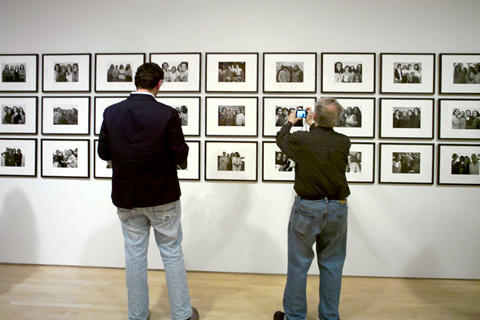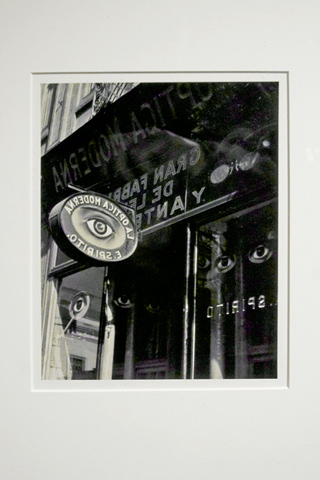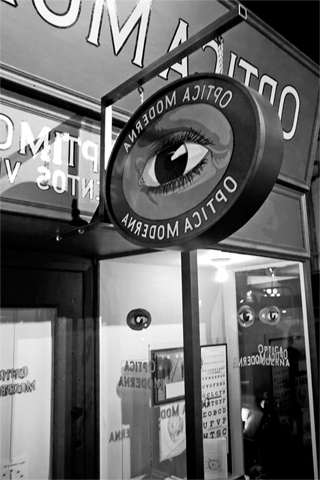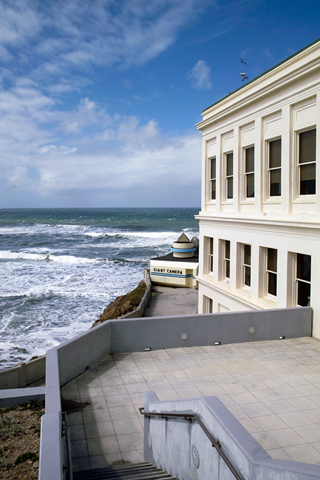Although I was quite busy in San Francisco shooting five David Baker housing projects, and the arrival of my family for a week’s sightseeing only made things busier, I did eventually find time to see some photography at SFMOMA. There was lots to see there, but a couple of unexpected moments elsewhere seem more significant in retrospect than anything I saw in the museum.
I was happy, however, in SFMOMA to come across the wall of Nicholas Nixon photographs of the Brown sisters, part of the museum’s 75th anniversary show. I’d seen images from the series many times, but never the whole thing together. He has photographed the foursome, which includes his wife, every year since 1975. Although the images were not made in the same setting, Nixon has maintained the order of posing, consistent distance, black and white film, and use of an 8×10 view camera. There is little artifice evident in the way he has photographed these women, yet there is something singularly compelling about the images and the faces staring so intently at the photographer, and at us.
Nixon began this series in 1975 the same year as the exhibition New Topographics, in which his urban landscapes were shown. His portrait of the Brown sisters carried over the idea of objective landscape description to the human figure, foreshadowing the work of Thomas Ruff and Rineke Dijkstra, among others.
The Brown Sisters by Nicholas Nixon — © Brian Rose
Visitors to the gallery at SFMOMA kept snapping pictures of the installation, moving from the youngest to the oldest–which is what everyone does–watching the course of time act upon these resolute, independent, visages. It is a discomforting voyeurism, but we are all in this together, our own aging mirrored on the wall, in this powerful collusion between photographer and subjects.
Parábola óptica (Optical Parable) by Manuel Alvarez Bravo
On a rainy day we went to the Exploratorium, a cacophonous interactive science museum housed in the former Palace of Fine Arts, part of the 1915 Panama-Pacific International Exposition. Unique to this museum, science shares the spotlight with “art and human perception.” In the midst of various exhibits on visual and auditory perception I came across the photograph above by Manuel Alvarez Bravo. It is an image of an optician’s storefront reversed so that the signage is seen backwards. Next to the photograph, the museum had built a full scale mock-up of Bravo’s optician’s shop. I made my own Bravo below with my digital camera.
The text panel adjacent to the photograph:
Our “storefront” was inspired by a photograph taken in 1931 by Manuel Alvarez Bravo. Much of Bravo’s work explores the interplay between opposing ideas, such as the cultural differences between urban and rural Mexico. In Parábola óptica, Bravo presents an optician’s store in a way that highlights the paradoxical nature of seeing. For example, the store provides instruments designed to make seeing easier, yet the picture itself is reversed so that the store’s name is difficult to read. The store’s name, La Optica Moderna, literally translates as “the modern optician,” but it’s been said that a broader translation is “the modern viewpoint.” Perhaps interpreting Bravo’s storefront in this ambiguous way suggests the difficulty of seeing clearly in a world filled with contradictions.
Yes, I said out loud to myself. The difficulty of seeing clearly in a world filled with contradictions. That’s what this business is all about. I wanted to share this “find” with someone else, but my son had dashed ahead to another hands-on exhibit, while my wife sat in the museum cafe reading a mystery novel.
Camera obscura at Cliff House — © Brian Rose
I wanted my son to see the Pacific Ocean before we returned to New York, so we drove to Cliff House at Land’s End on the western edge of San Francisco. We walked some of the trails along the rocky shoreline, as an unusually turbulent sea crashed against the rocks. I also wanted to show him the camera obscura perched almost precariously above the ocean with its 360 degree projected image inside.
There is nothing more basic to photography than such a device, which was known to the renaissance painters and architects. Much of our awareness and understanding of two dimensional perspective is derived from images made with the use of camera obscuras. Photography only became possible with the invention of a way to fix those images on a light sensitive plate or paper surface.
But alas, the “giant camera” was closed, the pavilion rusty and forlorn, the sky and crashing waves unseen within its dark interior.




I agree seeing all of the Brown Sisters photos is so much better than seeing a few here and there. I just saw the Brown Sisters pieces at Phoenix Art Museum, such a great collection.